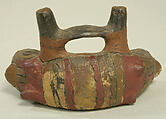Double Spouted Vessel with Snake
Not on view
Unusual for its small size, this double spout and bridge vessel’s body is a composite creature. A snake body with feline heads on both ends this C-shaped vessel is in the form of an otherworldly creature from Paracas mythology. The two-headed creature has an unusual orientation, seemingly prone on its side. Incised double half-circles, at the top and base of the vessel, suggest eyes. On each head, applique forms the feline face’s pointy ears, snub noses and a toothy grimace on each terminal end. The small, triangular ears, nose, and bared teeth recall the feline imagery often depicted in embroidered Paracas textiles and other ceramics such as seen in the MMA collection’s 1979.206.1148. Although some of the post-fired pigment has worn away, remaining paint indicates use of alternating color system favored in early Paracas ceramics, an ochre-red and sulfurous yellow. Incised lines delineate these areas of color and the animal’s features and are suggestive of snakeskin or feline pelt markings.
The two-headed figure on its side makes this vessel different than other iterations of the double-headed serpent, where heads are commonly depicted facing forward so both sides of the face are visible. The C-shaped vessel form is often used to depict double-headed, hybrid creatures, such as snakes with cat attributes. Despite its serpent body, the feline-head is similar to other vessels from the Met’s collection; 63.232.24 shows a more conventional arrangement of the C-shaped ceramics. Vessels of this type may have held small amounts of liquid for rituals. This vessel exemplifies a fascination with otherworldly animals and duality of the Paracas culture of southern Peru.
The fabrication and ornamentation of this container is less precise than those typically seen in ceramics of this type, suggesting that it might have been the work of an apprentice or younger artisan or made in haste for burial. The body of the vessel was hand-formed, perhaps by coiling, with the spout and bridge added later. Incising was done before the clay was completely dry. The vessel’s burnished, unpainted black spouts indicate that it was fired in a reduction kiln, to which smoking fuel was added. The resulting soot adhered and integrated with the clay surface, resulting in a dark satiny finish. This technique, known as “smudge blackware” is commonly found in Paracas ceramics.
Painted decorations, applied after the firing process, are another iconic characteristic technique of Paracas ceramics. The precise paint formulation is unknown though it likely consisted of ground mineral pigments mixed in an adhesive plant-resin base. Because this process results in vessels with delicate surfaces, it’s believed that they were intended for ceremonial or ritual purposes. In addition to their vibrant ceramics, Paracas artisans were remarkably skilled in the production of intricately embroidered textiles. Both media share coloration and iconography and were likely integral to their spiritual practices as well as daily life. A textile fragment in the MMA collection 33.149.15 also features similar depictions of fantastic hybrid creatures.
During the first millennium B.C., the people of Paracas society skillfully manipulated their limited water resources of the coastal desert to build a thriving agricultural society along in the river valleys of the south coastal of present-day Peru. They also took advantage of the rich marine resources as a result of the Pacific’s Humboldt Current providing the population access to a varied diet. Long-distance trade relationships are evident in the materials used to produce their textiles and ceramics.
The Paracas culture was unknown until 1925 when archaeological excavations by Julio Tello revealed the cemetery complexes of Wari Kayan, located on the arid Paracas peninsula that juts into the Pacific, south of Lima. The excavations exposed burials of over 400 mummies accompanied by richly decorated textiles and ceramics and interred over the course of three hundred years. Commonly referred to as “mummy bundles,’ the preserved bodies of individuals, along with grave goods such as gold jewelry and ceramics, were wrapped in dozens of layers of richly decorated garments and textiles, sometimes numbering in the hundreds. The sack-like mummy bundle was interred in a shallow individual or group grave in desert conditions. The extraordinarily dry, desert conditions of the Paracas Peninsula were instrumental in preserving the mummy bundles for over 2,500 years. This small vessel likely comes from a Paracas mummy bundle.
Sarah Reetz, M.A. candidate, Bard Graduate Center, 2017
Other Related Objects
1976.287.18
33.149.15
References and Further Reading
DeLeonardis, Lisa. “Encoded Process, Embodied Meaning in Paracas Post-Fired Painted Ceramics,” Making Value, Making Meaning: Techné in the Pre-Columbian World, edited by Cathy Costin, pp. 129-166. Washington D.C.: Dumbarton Oaks Research Library and Collections, 2016.
DeLeonardis, Lisa. “Interpreting the Paracas Body and its value in Ancient Peru.” In The Construction of Value in the Ancient World, edited by John K. Papadopoulos and Gary Urton, pp. 197-217. Los Angeles: Cotsen Institute of Archaeology, University of California, Los Angeles, 2012.
Donnan, Christopher B. Ceramics of Ancient Peru. Los Angeles: Fowler Museum of Cultural History, University of California, 1992.
Sawyer, Alan Reed. Ancient Peruvian Ceramics: The Nathan Cummings Collection. New York: Metropolitan Museum of Art, 1966.
Proulx, Donald A "Paracas and Nasca: Regional Cultures on the South Coast of Peru". In Handbook of South American Archaeology. edited by Helaine Silverman and William Isbell, add page numbers. Springer Science & Business Media, 2008.
Proulx, Donald A. A Sourcebook of Nasca Ceramic Iconography: Reading a Culture Through Its Art. 1st Edition edition. Iowa City: University Of Iowa Press, 2009.
Stone-Miller, Rebecca. Art of the Andes: From Chavín to Inca, 3rd edition. New York: Thames & Hudson, 2012.
Due to rights restrictions, this image cannot be enlarged, viewed at full screen, or downloaded.

